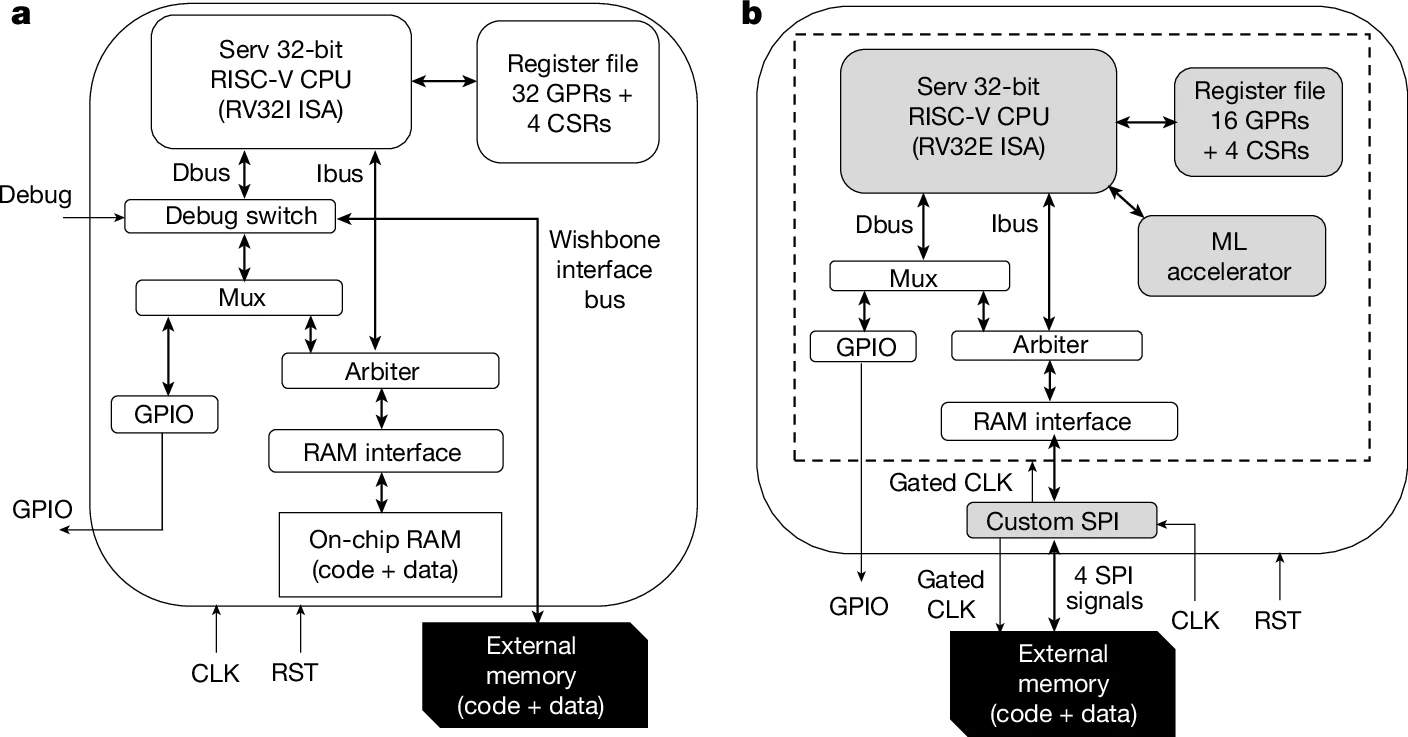The Flex-RV microprocessor, being developed by Pragmatic Semiconductor microchip engineers, is an ultralow-cost, conformable 32-bit RISC-V microprocessor for emerging applications. It is based on an open-source, 32-bit RISC-V central processing unit (CPU) extended with machine learning (ML) features fabricated with indium gallium zinc oxide (IGZO) thin-film transistors (TFTs).
A very affordable bendable microprocessor is made possible by Flex-RV, a 32-bit microprocessor built on an open RISC-V instruction set and constructed using indium gallium zinc oxide thin-film transistors on a flexible polyimide substrate.
Additionally, Flex-RV incorporates a hardware accelerator for programmable machine learning (ML) into the processor and presents additional instructions that expand the RISC-V instruction set to accommodate ML workloads.
It is put into practice, made, and shown to run at 60 kHz with less than 6 mW of power consumption. Its performance under flat and tight bending conditions is tested when built onto a flexible printed circuit board, with an average performance fluctuation of no more than 4.3%.
With its sub-dollar open standard non-silicon 32-bit microprocessor, Flex-RV ushers in a new era of computing accessibility and opens up new applications in wearables, medical devices, and smart packaging.
Because of their cost and form factor, emerging applications like fast-moving consumer goods (like smart labels and packaging), healthcare wearables (like smart patches and dressings), single-use implantables (like neural interfaces), and single-use test strips (like lateral flow tests and microfluidics) have not yet included microprocessors.
The primary issue that determines the feasibility of various applications, namely in smart labeling and product packaging, is cost.
Because the RISC-V ecosystem promotes innovation and does not impose restrictions on expansions or modifications (like new instructions), designers can customise the microprocessor to meet specific demands without worrying about extra fees or license restrictions.
A flat sample could be bent around a pencil without breaking, the researchers discovered during testing. They also discovered that IGZO transistor printing could be done on the material. The outcome is a RISC processor known as the Flex-RV by the researchers.
The current demonstration chips are limited to a 60 kHz frequency due to their 17.5 square millimeter core size and 12,600 logic gates. The open-source RISC-V architecture is also used by them. While the computers are more than capable of processing important statistics like body temperature or cardiac rate, they would not be quick enough for large-scale applications.

IGZO TFTs, which have an orders of magnitude smaller carbon footprint per FlexIC than an equivalent Si fab6, can be used to create flexible chips or FlexICs at Pragmatic’s FlexLogic fab. Because FlexICs are not brittle and can withstand mechanical stress like bending, they do not require extra chip packaging (such as plastic or ceramic) like Si dies to protect them from mechanical stress.
This allows for bending capabilities and further drives down the cost of microprocessor units to sub-dollar levels at huge volumes.
Flex-RV is different from previous non-silicon microprocessors in three aspects:
(1) It is possible to program the 32-bit CPU to execute any compiled program written in high-level languages (like C).
(2) Because RISC-V is open-source and allows for the addition of additional instructions to the ISA, Flex-RV also includes a programmable ML accelerator that is closely connected to the CPU and has unique RISC-V instructions added.
(3) By assembling the microprocessor bare die onto a flexible printed circuit board (FlexPCB) using a novel technique created for this work called over-edge printing, or OEP, the researchers demonstrate the microprocessor’s functionality beyond wafer-level testing. In contrast, all previous works were demonstrated at the wafer level without the microprocessor being released from the glass carrier and diced.
This made it possible to run the scripts to verify the functionality under mechanical stress and do actual bending tests on the Flex-RV. We measure the performance throughout multiple test programs and show how the Flex-RV integrated onto the FlexPCB functions.
According to our findings, Flex-RV built on a FlexPCB may operate at up to 60 kHz with a power consumption of less than 6 mW and can be bent to a curvature of less than 5 mm without compromising program execution.
This discovery opens the door to the next wave of intelligent, pervasive computing, where smart sensing is embedded into common things through the integration of programmable, flexible processors with machine learning capabilities.
The RISC-V architectural compliance suite24 for RV32E ISA has been used to validate Flex-RV. Additionally, a number of test benchmarks were created to confirm its functionality. These were produced using the RISC-V GNU compiler tools and written in C with some inline assembly code.
A significant step in creating a bendable computer that is ultralow-cost and independent of traditional electronic components is Flex-RV.
The processors only need 6 mW of electricity, according to the researchers. According to their calculations, the researchers could produce the processors for as little as $1, making them disposable.
The Full Article Can Be Read At, Nature




